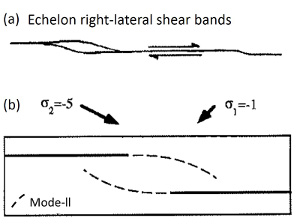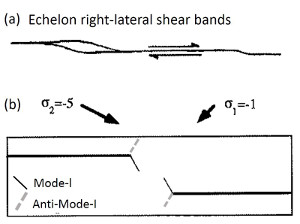| |||||||
|
|
|||||||
|
|
|||||||
| Mechanisms and Mechanics of Echelon Shear Bands | |||||||
|
Once fractures initiate at multiple points and propagate towards each other, they invariably become off-line or non co-linear. This is known as 'echelon structure.' Echelon opening mode fractures, joints, closing mode fractures, pressure solution seams, and their mechanisms and mechanics were described in corresponding categories. Conceptually, deformation bands of shear and volumetric bands are similar. The propagation modes of interacting off-line shear bands are informative for several reasons including propagation of bands in shearing mode (mode-II) and mode-I and anti mode-I modes. Figure 1 and Figure 2 illustrate a variety of modes and their paths simulated (Du and Aydin, 2003) using a criterion based on the Strain Energy Density (Timoshenko and Goodier, 1970, 3rd ed., p. 247-248) and Displacement Discontinuity Method (Crouch and Starfield, 1983). Based on the loading (the direction and magnitude of the remote stresses and the material properties), it is possible to map the theoretical paths of the shear bands and dilation and compaction bands. Band simulations using different approaches were also investigated by various authors, for example, Sternlof et al. (2005).
| |||||||
| Reference: |
|||||||
| Crouch, S.L., Starfield, A.M., 1983 Du, Y., Aydin, A., 1993 Sternlof, K.R., Rudnicki, J.W., Pollard, D.D., 2005 Timoshenko, S.P., Goodier, J.N., 1970 |
|||||||
|
Readme | About Us | Acknowledgement | How to Cite | Terms of Use | Ⓒ Rock Fracture Knowledgebase |
|||||||

